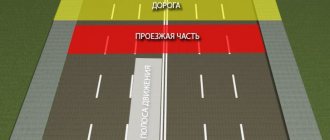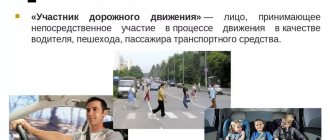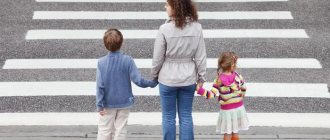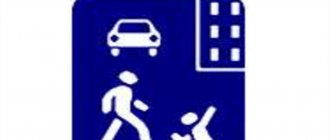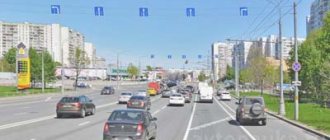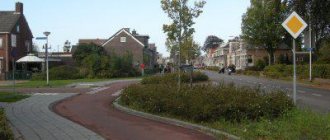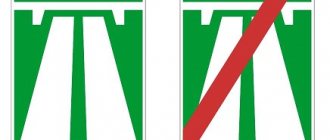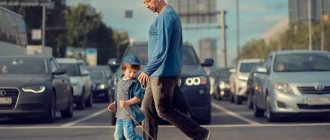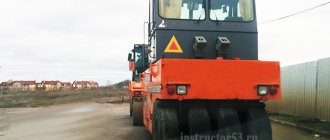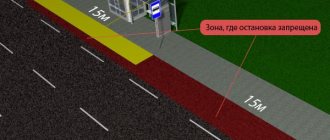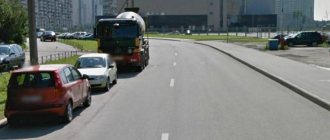Road communication is the most important part of the economy of any country, because it plays an important role in the level of development of industry and production of the state. And Russian roads are no exception in this regard. In order to determine the level of quality and traffic flow, a list of specific requirements for roads has been developed. Those of them that fully meet the presented criteria are capable of accepting transport flows of any complexity and completeness and facilitating the delivery of passengers and cargo in all directions and over any distance. That is why it is worth paying close attention to the question of exactly what categories of highways exist and how they are classified.
How everything works
To increase traffic safety and improve cross-country ability, a modern highway is developed as a complex technical structure and is built on a specially designated area of terrain called a right-of-way. There the roadway itself is constructed, along which vehicles move. To ensure increased throughput, driving comfort and traffic safety, almost all types of roads are equipped with hard surfaces: asphalt, concrete and other construction materials. The width of the carriageway for a single-lane road is at least 7 meters. A small part of the right-of-way does not have a hard surface and is not included in the road surface - it is used as additional area. Detour roads and bicycle paths are laid here, and this part of the road is also allocated for the movement of tractors and horse-drawn vehicles. Additionally, in this part of the right-of-way, drainage and forest protection structures are installed, and when repairing the road surface, construction materials are immediately stored.
In addition to the roadway, the roadway also includes two curbs - to the left and to the right of the roadway. These additional lanes are used for exiting (both accidental and forced) from the main part of the road, and can also be used as an auxiliary lane when passing or repairing the road surface. Different types of roads have shoulders of unequal width: from 2 to 3.75 meters. To drain water from rain and snow, ditches are installed on both sides of the road - ditches with a depth of 0.3 to 1 meter. Regardless of the class and category, all road surfaces are not made flat, but in the form of a gable roof with an inclination angle of 1.5 to 4 degrees. This allows rainwater not to linger on the canvas, but to flow freely into the ditches.
Stop
The legislator in the traffic rules reflects the concept of stopping transport. You can stop on the right side, on the side of the road. If there is none, the stop is organized on the part reserved for travel, or at its edge. In some situations, cars stop on sidewalks. Stopping is not allowed at intersections. When there is a shoulder to the right of the roadway, you can only stop there. If the specified space is occupied, then it is not allowed to place the car on the part reserved for travel.
Transitions cannot be used to stop. You can park your vehicle on the roadway. The main condition will be the absence of a curb. It is noted that the car should be located as close to the curb as possible. Stopping on the sidewalk will be an exception. Signals are not required when stopping.
Sometimes you can stop traffic on the left side. This is permissible in a populated area or on a one-way road. This rule also applies to situations where there are two lanes in different directions.
Different categories
Categories of highways in different countries of the world have various evaluation criteria, however, by generalizing them a little, we can make approximately the following list:
- E - overpasses of European significance;
- M - routes of federal significance;
- R - roads connecting administrative centers;
- A - federal and regional highways, approaches to the largest transport hubs - airports, sea and river ports;
- K - regional roads;
- N - other local roads.
There are also several other criteria by which roads for different purposes can be classified:
- by coverage width and number of lanes;
- according to the principle and method of crossing with different types of roads;
- by the presence or absence of markings and dividing strips.
It is the last dividing principle that says whether the road is operational, whether it intersects with other roads and how many times, how traffic is regulated, how many turns there are and other parameters.
Principles of classification
Basically, all roads are classified primarily based on the principle of how traffic is carried out and how easy access is provided to them. If we consider the categories of roads from this position, we can distinguish 3 main classes:
- motorway;
- expressway;
- ordinary road.
Each of them has its own subclasses, that is, it is divided into types depending on the geographical location:
- regional;
- regional;
- territorial;
- regional;
- national;
- international traffic;
Of course, such a division is rather arbitrary, but in practice everything is somewhat more complicated. The fact is that each country adopts its own categories and signs of division - in Russia, for example, there are five categories of roads, and in Ukraine there are only four.
Lane
Markings are used to divide the roadway. As a result of this division, several lanes are obtained for the movement of vehicles. The law defines them as one of the lanes located on the roadway. It must have a certain width. The width is set as a sufficient distance for a car to pass in one row. Movement along the lane must meet the requirements of sufficiency and safety.
A traffic participant may find himself in a situation where the lane markings are not placed on the lane or are not visible. Then you will need to determine the position on your own. You will need to mentally divide the road into two equal parts. The area on the left is where the oncoming car is moving. This driver can move on the right. Several lines can be drawn. Depending on the width of the site, there may be several lanes for movement.
First category
The first category of roads in Russia includes motorways, expressways and highways. Such overpasses have a width of at least 15 meters and are equipped with a dividing strip. There are at least two lanes in each direction, at least 3.75 meters wide. Such roads are designed for high traffic volumes and are equipped with high-quality concrete pavement that can withstand a large influx of vehicles. The capacity of such overpasses exceeds 7,000 cars per day, while vehicles move at a speed of at least 120 km/h.
Speed is the main risk factor
Let us remember that all road users sometimes make mistakes. If we take this as a starting point, we will inevitably come to the idea that streets and high speed vehicles are incompatible. Even if a driver follows the rules of the road, there may always be a pedestrian or cyclist who does something wrong - accidentally or intentionally, it doesn't matter - mistakes on the roads should not be punishable by death or injury for anyone!
At high speeds, the driver will have less time to react to the mistakes of other road users and the consequences of the collision will be more severe. At lower speeds, many collisions can simply be avoided because the driver will have time to react and brake, and if a collision does occur, the consequences will be less severe.
This raises the question: how can we force drivers to move along city streets at a safe speed? In domestic practice, the rule is that the roadway of streets should be designed with a certain speed margin. For example, the estimated speed on most streets in our country is 80 km/h, although in fact it is only allowed to move at a speed of 60 km/h. It is believed that this margin allows drivers to correct minor driving errors, especially if they are driving at a speed limit that is less than the calculated speed.
This is not what happens in reality. In reality, what happens in psychology is called “risk compensation.” People change their behavior depending on the perceived level of risk. If the perceived level of risk decreases, people begin to behave less cautiously and vice versa.
In terms of traffic, this means that if we design a street based on a design speed of 80 km/h and set the speed limit to 60, the majority of drivers will not drive at 60 km/h, but will drive at the same speed. which they perceive as safe for themselves. And this is what we see in reality - if traffic density allows, then on many of our roads drivers drive at a speed of 80-100 km/h. And this has nothing to do with consciousness or law-abidingness. It is simply a natural behavior dictated by the environment.
At the same time, this safety perceived by drivers is quite conditional and illusory. At any moment, something unexpected can happen: a pedestrian finds himself on the roadway, a driver from a perpendicular street runs a red light, a cyclist makes an unexpected maneuver - and all this safety ends in an accident with injuries and deaths.
Simply put, over-designing streets does not lead to safety, but rather to riskier driver behavior.
Fourth and fifth categories of roads
The fourth category of roads is characterized by the presence of a coating of rather low quality. Because of this, movement along them can be very difficult, especially in the autumn-spring period. Such tracks can carry no more than 1,000 vehicles per day, and the speed along them is limited to 80 km/h. For heavy vehicles, passage on such roads is most often completely closed, due to the fact that the movement of heavy vehicles leads to rapid and serious destruction of the road surface.
A striking representative of the fifth category is the “classic” country road. Roads in this category most often do not have any surface at all, and it is unlikely that you will be able to drive along them at a speed exceeding 60 km/h.
so UNT / Traffic rules / Lesson plans for traffic rules 4th grade
LESSON 3. Topic: The road and its components. Road intersections. Types of intersections and traffic rules for them
20.11.2013 14684 0
Purpose of the lesson: To form in younger schoolchildren an idea of the meaning of new terms: street, road, roadway, sidewalk, pedestrian path, curb, lawn, traffic island. Teach the rules of disciplined behavior on the street, develop a sense of anticipating danger when crossing the roadway.
New words: Street, road, roadway, sidewalk, pedestrian path, curb, lawn, traffic island.
Contents of the lesson
1. The teacher’s story and his conversation with the students The teacher reminds the students that in Russia they drive on the right hand side. Together with the students they remember what it is.
There are a lot of cars moving on the roads. To prevent them from colliding, road markings are applied on the roadway, i.e. draw lines and arrows. A solid white line (one or two) divides the roadway and is needed to ensure that some cars drive in one direction and others in the opposite direction. The teacher explains that such traffic movement is called two-way traffic.
If cars travel in only one direction across the entire width of the roadway, then such traffic is called one-way traffic. It is prohibited to move against the flow of traffic on such roads.
The teacher asks students to remember what they know about the road and its main elements.
The concept of “street” includes everything that we see in front of us: houses, sidewalks, lawns, roadways along which traffic moves, tram tracks, roadsides, courtyard areas.
A road is a part of a street equipped and intended for the movement of vehicles and pedestrians. It includes the roadway, tram tracks, sidewalks, and roadsides.
A carriageway is a part of the road intended only for traffic.
A sidewalk is a part of the road intended for pedestrian traffic. Cars cannot drive on sidewalks.
If there is no sidewalk, then pedestrians move along the sides. Sometimes cars can drive onto the side of the road.
To drain water, special ditches called ditches are installed along the road. A pedestrian path is a part of the road intended for pedestrian traffic only. A bicycle path is a part of the road intended for cyclists only. If there is no sidewalk or pedestrian path, pedestrians can also move along it.
Sometimes sidewalks are separated from the roadway by lawns on which trees or flowers are planted.
On large roads (highways), a wide dividing strip is made, sometimes with a lawn or bushes, which separates traffic flows in opposite directions. Pedestrians and vehicles are prohibited from standing on the median strip.
When crossing a wide roadway, pedestrians sometimes do not have time to complete the crossing. Then, in the middle of the road, special safety islands are set up, where they can wait for the traffic light to turn green again and complete the crossing. The teacher once again emphasizes that cars move at high speed along the roadway, so it is dangerous to go out on it, especially in front of nearby vehicles. The car cannot stop immediately. After pressing the brake pedal, it continues to move by inertia for some time and can run into a pedestrian. Therefore, you can cross the roadway only after making sure that the car is far away.
The teacher asks the students a question: “How to cross the road correctly?” In places where there is a traffic light, a zebra crossing, there is no transport or it is far away. In this case, you do not need to run, but look in both directions and calmly cross the road.
You should walk on the sidewalks on the right side so as not to interfere with the movement of other pedestrians. You cannot move next to the roadway on curbstones, ride scooters, roller skates, or sleds. You cannot play on the sidewalk - it interferes with pedestrian traffic. You can play and ride bicycles, scooters, skateboards, and roller skates only in courtyards, on playgrounds or sports grounds, and in stadiums. Bicycles can only be ridden on the roadway from the age of 14.
If there is a pedestrian path along the road, you need to walk along it, keeping to the right.
If the road does not have a sidewalk or pedestrian path, you can walk along the side of the road. In this case, you need to move on the left side of the road towards traffic so that you can see it and take precautions by stepping aside from the roadway.
The teacher emphasizes that even on the sidewalk you need to walk carefully and be attentive, because a car can unexpectedly leave the yard.
The teacher explains to students why they should not go out on wide roads unless accompanied by an adult. Transport there moves in several rows, and drivers may not notice a child standing alone on the roadway due to his small stature. This could end in an accident. Therefore, when crossing the road with adults, children should hold their hand tightly.
On a wide carriageway with two-way traffic, if pedestrians do not have time to cross it, they can stop on the line dividing traffic flows in opposite directions to let approaching traffic pass.
It is especially dangerous to organize bicycle races on the roadway, play ball, skate or ski while clinging to the back of a car. Most often this ends tragically for children.
Then the teacher reminds students that they have previously been familiar with the term intersection. An intersection is a place where roads intersect. An intersection is a very dangerous section of the road, as vehicles are moving in different directions. For safety reasons, drivers and pedestrians need to know and follow the rules for driving and crossing the intersection.
There are different intersections. There are four-way intersections where the streets intersect at right or acute angles. Three-way intersections resemble the letters "T" or "Y". Intersections where several streets intersect or originate are called squares.
The part of the street located between two intersections is called a block.
An intersection where traffic is controlled by traffic lights or a traffic controller is called a controlled intersection. If there is no traffic controller or traffic lights at an intersection, it is called unregulated (uncontrolled).
The teacher draws students' attention to the fact that when crossing an unregulated intersection they must be very careful. You can cross it only at right angles to the edge of the roadway. If you go diagonally rather than in a straight line, the path will be longer and you will have to spend longer on the roadway. Is it dangerous.
Crossing the road at a controlled intersection is also not easy, because there are several traffic lights installed at once. Each of them has red, yellow and green signals on two, three and four sides. When crossing the road at such an intersection (children should do this with adults), you need to look at the traffic light for pedestrians.
At the end of his explanation, the teacher once again clarifies the rules for crossing the intersection and gives instructions for their comprehension, awareness and memorization.
1. You need to look at the pedestrian traffic light located on the opposite side of the roadway you are about to cross.
2. At a controlled intersection with a traffic light and a zebra crossing, you should turn to the green signal, following the rule: stop in front of the roadway, look back, forward, left, right and make sure it’s safe.
3. An unregulated intersection should be crossed at a zebra crossing according to the same rule.
4. It is only necessary to cross the roadway at a controlled or unregulated intersection straight across the traffic, and not diagonally.
2. Practical task The teacher asks the students to solve the crossword puzzle on their own. The winner will be the student who answers the fastest and most correctly.
Vertical: Where roads intersect.
Horizontal (in order):
A place where several roads intersect or begin.
An element of the road intended for pedestrian traffic.
A road user walking on the sidewalk.
A part of a street located between two intersections.
Road markings indicating where pedestrians cross the roadway. A technical device that regulates the movement of vehicles and pedestrians. A ditch along the road designed to drain water.
An element of the road adjacent to the roadway on which pedestrians can move in the absence of a sidewalk.
A man in uniform and with a staff in his hand, ensuring order on the roads.
A game
Students are divided into two groups of 3-5 people - drivers and pedestrians. In the hands of drivers are drawings with vehicles depicted on them. One of the students has three circles in his hands - red, yellow and green - he will represent a traffic light.
When the traffic light turns green, vehicles and pedestrians begin to move. At the same time, vehicles interfere with the movement of pedestrians when making turns. Then the students change places.
4. Questions to consolidate knowledge
1. Where should pedestrians walk?
2. Where can pedestrians walk if there is no sidewalk or walkway?
3. Where should cars go?
4. Why can’t you play snowballs on the sidewalks?
5. Where can you ride bicycles or scooters?
6. At what age can you ride a bicycle on the road?
7. Which movement is called two-way and which is called one-way?
8. Explain the term “right-hand traffic”?
9. What types of intersections do you know?
10. Which intersection is called a “square”?
11. What is a quarter called?
Forest roads - classification
A separate type of classification can be called the purpose of roads. Forest roads are a separate type of roads in Russia. As is clear from the name, they are located in forested areas and serve for hassle-free transport access to these parts of Russia.
Forest roads can also be divided into several types depending on their functional purpose:
- forestry - designed to monitor the condition of forest areas, it is along them that rangers walk around the territories entrusted to them;
- timber carriers - provide transport links when felling timber for industrial and sanitary purposes; since heavy freight vehicles move along them, they are additionally strengthened to ensure increased cross-country ability for heavy vehicles;
- fire protection - designed to provide fire crews with access to potential fires;
In earlier times, one more type of road could have been added to this list - a flat road, but now they are practically not built, and the old ones have long since fallen into disrepair. The fact is that the road surface in this case is a deck made of solid logs. It is possible to build such a road quickly, but it is impractical - after all, wood is not cheap these days, and a lot of it will be spent on such a road. And the service life of such a coating compared, for example, with asphalt, is short; the wood quickly rots and deteriorates in unfavorable weather conditions.
The road and its components
Once upon a time, in the old days, there were no roads that were familiar to us. From one settlement to another, people moved along forest and field paths. But gradually there were more and more roads and they took on an increasingly well-groomed appearance. The Romans in Europe and the Incas in America paved roads with stone and rubble and laid hard surfaces.
Roads in cities also began to be improved. In Russian cities, wood was used for their construction; in European cities, cobblestones and crushed stone were used.
Gradually the roads became the way we are used to seeing them.
So, a road is an artificial structure specially adapted for the movement of vehicles and pedestrians. Roads in cities can be called differently: street, avenue, lane, line. All of them consist of three components - the roadway, the sidewalk, and the curb. If the roadway is separated by green spaces, the road is called a boulevard.
The carriageway is the part of the road intended for traffic. And it is called that because cars, buses, trolleybuses, trams and other vehicles travel along it.
The roadway is intended for vehicles only. Pedestrians are not allowed to walk on it.
But the sidewalk is intended for pedestrians. This word is French, and translated it means “road for pedestrians.” In cities, sidewalks are usually covered with asphalt.
The sidewalks are slightly raised above the roadway. This is done so that any pedestrian can clearly determine the boundary between the roadway and the sidewalk. This border is marked with special stones that form a curb. On those streets where there are especially many pedestrians and cars, sidewalks are separated from the roadway not by a curb, but by metal fences.
Pedestrians should only walk on sidewalks.
What kind of roads are there?
Did you know that roads can be very different, depending on how the traffic on them is organized?
If cars drive down the street in only one direction, then such traffic is called one-way traffic. This is not to say that there are a lot of such streets, but they exist. And you should know how to behave on a one-way street.
On most streets, cars drive in both directions. This type of vehicle movement is called two-way traffic . To prevent cars from colliding and interfering with each other, such streets are divided by a solid white line (one or two). This line divides the roadway and is needed so that some cars drive in one direction and others in the opposite direction.
Another feature of roads is the direction in which traffic moves along them. In our country, traffic on roads is on the right . This means that all cars in Russia move forward on the right side of the roadway.
Driving on the right is also common in countries such as the USA, France, China and Germany.
In some countries (for example, in the UK, Australia, India), traffic on the roads is different - left-hand . This means that all cars in these countries move forward on the left side of the roadway.
Depending on whether traffic in the country is on the right or on the left, public transport is designed differently. In those countries where traffic is on the right, the doors on buses, trams, trolleybuses, and minibuses for passengers to enter and exit are always on the right.
In Russia, traffic on the roads is on the right.
We recommend watching:
Can the vehicle stop immediately?
The history of the emergence of traffic rules. History of traffic lights
How does a traffic light work?
Pedestrian crossings
Road users. Why are traffic rules needed?
How important is it to repair roads?
As you know, not all Russian roads can boast of new high-quality pavement, but this is one of the most important factors that should not be neglected. Quite a lot depends on the quality of the road surface, because to ensure a quality life for people, cargo transportation (not to mention passengers) must be carried out as quickly, safely and efficiently as possible.
Often, the inconsistency of the road surface with the requirements of modern transport realities and the ever-increasing traffic flow can lead to many negative consequences: an increase in the number of accidents, accelerated wear and tear of vehicles, excessive fuel consumption, a decrease in traffic speed and many others. It’s scary to even imagine that, for example, someone’s life may depend on which road a particular medical drug is delivered or how quickly a fire truck can arrive. So the road surface also plays a significant role in the classification.
Roads and streets are not the same thing
People who propose such solutions, unfortunately, do not make a difference between “roads” and “streets”. For them, these are all “highways” or simply “roads”. There are country roads and there are city roads, and the fundamental difference between them is a slightly different speed limit and some additional complexity associated with all these traffic lights and intersections, which make the city road network somewhat inferior in relation to the conventional ideal of a country highway. In the same logic - the construction of multi-level transport interchanges inside the city, and other measures to facilitate urban driving - flat turning radii, which can be entered at higher speeds, wide lanes, edge safety strips, etc. All this seems to bring us closer to the conventional ideal of the road, so in this logic all this needs to be done. Actually this is not true.
If we look at examples of countries with successful road safety practices, we see that “streets” and “roads” are completely different things, with different objectives and different ways of ensuring safety.
A road is a linear structure whose sole purpose is to ensure the movement of vehicles. This movement should be as unhindered, fast and safe as possible. All elements of the road serve to fulfill this task. Therefore, concrete bumpers, wide stripes, edge safety strips, shoulders, and smooth turns that can be entered at high speed are used on the roads. Trees and bushes are cut down along the roads so that when the car flies off the roadway it does not crash into any obstacles. In general, everything is done on the roads so that you can move along them at a sufficiently high speed, but so that the mistakes of road users do not lead to tragic consequences. Due to the fact that, from a functional point of view, a road is a rather primitive structure that serves a single purpose, this task is quite feasible.
The street is a completely different space! On the street, of course, like on the road, there is a roadway, and vehicles move along this roadway. However, this is far from the only thing happening on the street. Pedestrians also move here, cyclists ride, shops and cafes line the streets, there is parking on the roadway, public transport moves along the streets, people meet on the streets and spend time on them. In general, a street is a multifunctional space in which vehicle traffic plays a noticeable, but far from fundamental, role. In addition to him, the trajectories of many other traffic participants are intertwined here. In addition, when designing streets, we must take into account visual and aesthetic requirements, and for this reason, what is applicable on highways is not applicable on streets - the same concrete bumpers.
Classification of roads depending on coverage
Depending on the type of road surface, the following types can be distinguished:
- pavements;
- cement concrete;
- covered with gravel or crushed stone;
- ground;
- tar concrete;
- asphalt concrete;
- coated with materials containing organic substances having astringent properties.
Summarizing the above, we can once again note the importance and necessity of all work related to the arrangement and repair of roads, as well as maintaining them in proper condition. New technologies open up a lot of opportunities to ensure that both the country road and the highway remain at a decent level in terms of durability and quality of the coating and are able to provide high cross-country ability for vehicles.
roadway
Drivers often confuse the concepts of roadway and road. The traffic rules help you figure this out. It is a mistake to consider the road as asphalt on which cars drive. The specified element is only a component of the road. The roadway refers to the area over which trackless vehicles move. In this regard, we can conclude that the asphalt is laid not on the road, but on its carriageway.
Often it is asphalt that is considered as the main criterion for determining the roadway. In reality this is not the case. The assessment is given to what vehicles can pass through it. These are the ones that are not equipped with rails. The roadway can be covered in any way, depending on the base and other nuances.
